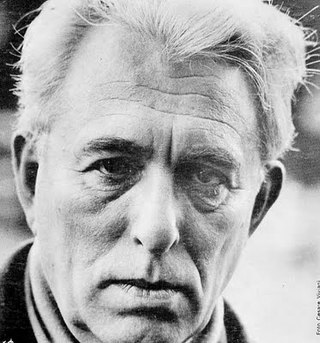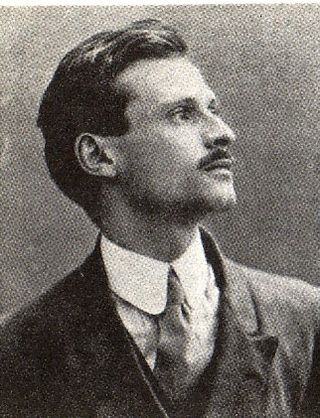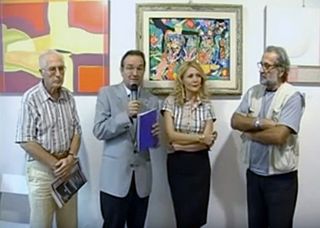
Paolo Savi was an Italian geologist and ornithologist.
Mauro Cristofani was a linguist and researcher in Etruscan studies.
The primary languages of Calabria are the Italian language as well as regional varieties of the Neapolitan and Extreme Southern Italian, all collectively known as Calabrian. In addition, there are 100,000 speakers of the Arbëresh variety of Albanian, as well as small numbers of Calabrian Greek speakers and pockets of Occitan.

Adolfo Targioni Tozzetti was an Italian entomologist who specialised in Sternorrhyncha. He was Professor of Botany and Zoology in Florence, associated with Museo di Storia Naturale di Firenze where his collection remains today at La Specola. He was especially interested in pest species, mainly mealybugs, scale insects and other pests that attack citrus and peaches. He described many new taxa.
The word titling, in the performing arts, defines the work of linguistic mediation encompassing subtitling and surtitling.

The Badia a Settimo or Abbazia dei Santi Salvatore e Lorenzo a Settimo is a Cluniac Benedictine abbey in the comune of Scandicci, near Florence in Tuscany, Italy. It was founded in 1004.

Gianfranco Pasquino is an Italian political scientist. Professor Emeritus of Political Science at the University of Bologna and Senior Adjunct Professor at SAIS-Europe (Bologna). He studied at the University of Turin under Norberto Bobbio and specialized under Giovanni Sartori at the University of Florence. In his professional life, he has been associated with the University of Florence, Harvard University, University of California, Los Angeles and the School of Advanced International Studies in Washington, DC and Fellow of Christchurch and St Antony's at Oxford and Life Fellow of Claire Hall, Cambridge.

Vittorio Umberto Antonio Maria Sgarbi is an Italian art critic, art historian, writer, politician, cultural commentator and television personality. He is President of the Museum of Modern and Contemporary Art of Trento and Rovereto. He was appointed curator of the Italian Pavilion at the 2011 Venice Biennale. Several times a member of the Italian Parliament, in 2008 he served as Cabinet Member for Culture, Arts and Sports in Milan's municipal government for six months when Mayor Letizia Moratti terminated his mandate as she saw him 'unfit for the job'. In 2012, he was removed as Mayor of Salemi by the Ministry of Interior after he failed to acknowledge Mafia interferences in his cabinet.
The Acqui Award of History is an Italian prize. The prize was founded in 1968 for remembering the victims of the Acqui Military Division who died in Cefalonia fighting against the Nazis. The jury is composed of seven members: six full professors of history and a group of sixty (60) ordinary readers who have just one representative in the jury. The Acqui Award Prize is divided into three sections: history, popular history, and historical novels. A special prize entitled “Witness to the Times,” given to individual personalities known for their cultural contributions and who have distinguished themselves in describing historical events and contemporary society, may also be conferred. Beginning in 2003 special recognition for work in multimedia and iconography--”History through Images”—was instituted.

Franco Fortini was the pseudonym of Franco Lattes, an Italian poet, writer, translator, essayist, literary critic and Marxist intellectual.
Antonio Bueno was an Italian painter of Spanish origin, who acquired Italian citizenship in 1970. He was born in Berlin while his journalist father was posted there by the newspaper ABC of Madrid.

Marino Moretti was an Italian poet and author.

Mauro Marrucci was an Italian artist born in Volterra, Italy on December 18, 1937 by artisans parents and he died November 15, 2014 in Grosseto. Since 1950 he is acting as the Alabaster craftsman and wood and began his artistic research, released by academic schemes, as a graphic designer and painter and makes experiences in the field of sculpture. In 1861 he won first teaching assignment in Tuscany where he continues to practice as a graphic designer, painter and designer. Since 1973, public writings of artistic teaching and non-fiction. In December 1974 on Public Education of drawing the essay "The educational dialogue through the work of art." He also collaborates with the magazine School and cities. In 1982 he moved to Milan to teach Design and Art History at the XIII High School. In 1986 he held the chair of architecture at the Art School "Pietro Aldi" in Grosseto until retirement. From 1957 to 2011 he took part in demonstrations in graphics and painting in Italy and abroad, receiving reports from the most qualified critics and several awards.

Antonio Garbasso was an Italian physicist and National Fascist Party politician. He was the 14th mayor and the 1st podestà of Florence, Kingdom of Italy.
Maria Idolina Landolfi was an Italian novelist, poet and literary critic. She was daughter of the writer Tommaso Landolfi and the principal curator of his works.

Assumption of the Virgin is a 1524-1526 oil on canvas painting by Moretto da Brescia, displayed as the high altarpiece in the Old Cathedral in Brescia.

Timothy Christopher Verdon, is a Roman Catholic priest and Art Historian, specialized in Christian Sacred Art on which he has written numerous books and articles. He has organized international scholarly conferences and curated exhibitions in Italy and the USA. He was born in New Jersey, United States, and has lived in Italy for more than 50 years, now residing in Florence.

Ettore Bignone was an Italian classical philologist and man of letters.
Carlo Francovich was an Italian politician, partisan and literary historian.

Holy Family with the Infant Saint John the Baptist and Saint Mary Magdalene is a 1508-1512 oil on panel painting by Palma Vecchio. It was in archduke Leopold William of Austria's collection in Brussels from 1653 to 1662 before being moved to the Imperial Galleries in Vienna, before finally being exchanged for another work with the Uffizi in Florence in 1793, where it is now inventory number 950.